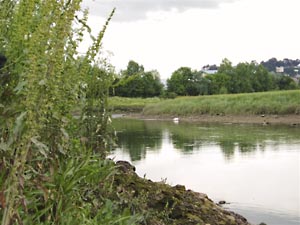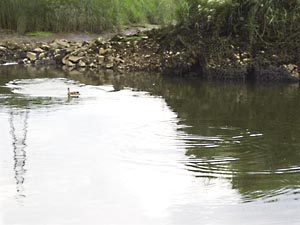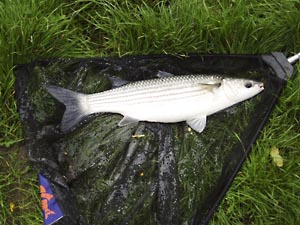 fishing Dartmouth sea angling torbay festival Devon uk charter boat shore plaice turbot bass river dart |
||||||
Mike Bailey Catches River Mullet on the Surface |
||||||
|
The River Teign in South Devon is just such an estuary, being wide and shallow, with fast currents and tides. Fish can often be observed in large numbers and to a good size, but they can be infuriatingly difficult to get feeding. The water is often so shallow that traditional methods using the float can be unproductive.
And so it was that I found myself on the river bank in the middle of August on a previously untried section of the river. It was exposed to the elements, wide and shallow, with a stiff westerly breeze down wind. Float fishing with the current and wind in the same direction was going to be difficult even using a heavy float well shotted down.. I had already prepared a very stiff mix of bread mash, and this was compressed into very tightly compacted balls. I lobbed heavy portions of ground bait towards the far bank and well upstream of where I planned to fish on a regular basis. I had already done some exploratory plumbing of the depth here, and it confirmed a shingly, gravely bottom that started out very shallow on my side of the bank, but which shelved smoothly into water to a maximum of four feet on the deeply undercut opposite bank, where the river took a sharp turn. This was to be my target area, where I suspected the fish would be lying in such an attractive area, and where fragments of food would be carried by the current. I used my trusted and powerful Drennan 13 foot float rod and 4lb line, using a very large chubber float, with most of the shot clumped near to the number 8 hook, to ensure that the bait was presented near to the river bed. Bait was a good pinch of bread flake squeezed firmly around the shank, leaving the barb exposed. Casting across the very stiff side wind, the float landed near to the far bank and immediately settled down to the rod tip. An upstream wind would have been ideal, slowing and holding the float back, and improving presentation, but at least the tide was easing, which would help to slow the bait on its down ward journey. The float quickly trotted down the swim and after holding it gently , (a bite often occurs as the bait lifts up and holds at the end of such a drift), I retrieved the tackle and cast out again. The wind meant that the line constantly needed to be mended to prevent a belly caused the line dragging across the surface. At first it looked pretty hopeless as the float raced downstream, but by casting right up to the opposite bank and sinking the line, it was possible to maintain contact. The slackening tide would soon change and as it did so, mullet from further downstream would start moving up the river and through the swim. When fishing somewhere completely new it always takes time to get the feel of the water, and so I slowly got used to the contours of the river bed, and noted the variations. Here a place where it shallowed and there where a clump of weed was positioned which could give “false” bites. Time spent like this is never wasted as much of successful fishing is based on intimate knowledge of different marks, and often one tiny feature can spell the difference between a productive mark and a stretch which is otherwise completely barren. Convinced that my approach would lead to success I persevered. Patches of bright sunlight dazzled on the water and the wind steadily increased, making it more and more challenging. Still, no bites resulted and yet the mark had that “fishy” feel that builds up after years of fishing in different waters, when you just sense that the fish are there. My float reached the bend where the bank was most undercut . It never wavered as it travelled along smoothly, but as I concentrated hard I sensed a slight “bulge” right by the side of my float. … I watched closely as it continued down to the end of the swim without any deviation at all. However, I was sure that there had been a slight movement in the water and once I had introduced some more ground bait, once again cast upstream and concentrated with every nerve tingling. As the float approached the undercut part, there was an unmistakable disturbance just under the surface of the water. A fish or fishes, were moving right by the surface, and taking fragments of bread that had not sunk in the fast flowing current. It was time to change tactics! The bait presented within an inch of the bottom was completely unproductive so I had to rethink.
First of all I mixed up some much looser ground bait which I knew would float or sink more slowly. I stopped fishing for a short time but concentrated on making sure that the small balls of ground bait were landing just upstream of the bend in the river. My polaroids eliminated the dazzling glare of the intermittent sunshine and allowed me to concentrate as a line of small bread particles floated downstream. Almost immediately there was a large swirl in the water and some of the bread had disappeared. Moments later the process was repeated. Mullet were taking the bread just under the surface, and the size of the disturbances indicated that these were good sized fish. I knew from past experience that surface feeding fish were often the larger specimens and that once they had started to take the bait confidently, they would feed freely as long as they were not spooked. I didn’t have any bubble floats in my tackle box which might have been the logical choice. However, I compromised by sliding all the shot right up to the float, leaving a short length to the hook of about two feet that was supported by a solitary dust shot. While I was doing this I kept adding more ground bait and watched with heart in mouth as the fish started to take confidently ever larger pieces with great splashing swirls. It was time to see if I could tempt one of these fish but I knew that I needed to concentrate and not to spook the fish. And so I threw in some more particles of bread and almost immediately followed with a gentle cast upstream of the feeding shoal. The bread flake landed without a sound and slowly started to sink just below the float. It is moments like this that make fishing such a wonderful experience. Everything had built up to this moment. I knew that the mullet were feeding greedily and I knew that one would take the bait. I also knew that the bite would be savage and as quick as lightning. I watched and waited expectantly as it flowed towards the bend but before I could move a muscle the float tore off sideways and the fish had gone, stripping the bait in the process.!! A boiling patch of disturbed water indicated where the fish had taken the bait. Cursing my incompetence for missing such a wonderful bite, I quickly re-baited, hoping that it hadn’t frightened the fish. Again, I took great care to ensure the bait landed gently and waited , tense and full of hope, as it drifted down in the current. And down past where I’d had my bite and on to the end of the swim. No sign at all of action, perhaps my chance had already gone? I carried on with decreasing hope as the next few trots down the swim saw no sign of any movement from a fish and not a flicker of the float. Had it just been a solitary feeding fish or had the commotion taken this so shy species away from the danger zone?!! After ten minutes my worst fears seemed to be realised but sometimes you just have to persevere even if it seems unlikely that you are going to get another chance. I cast out again and hardly had time to see the float settle before there was a mighty swirl just by the side of it. I struck instinctively, having barely had time to register the bite. I was rewarded by a tremendous thump and in front of me the water frothed and exploded as a spray of droplets were thrown in to the air. A heavy fish ripped off line with unbelievable power and the clutch howled in a banshee wail as line was ripped off. Then that sickening feeling as all went slack! The fish had thrown the hook and was gone, leaving me with that empty feeling that you can’t describe when you’ve lost a very big fish. Not for nothing is mullet fishing exasperating and frustrating on occasions. Convinced that this was the end of the action I still felt the need to go through the motions. I cast out again but without any hope or expectation, only to see the float bob slightly and then simply sink smoothly away. A firm strike and this time there was no mistake at all!! For a moment or two the fish held in the fast moving water, shaking its head in that characteristic way, and gleaming golden-yellow just below the surface. Then, realising it was in danger, it took off, disappearing in a frantic run upstream. In such shallow water it went off like a rocket and there was a horrible jarring and grating of the line as it touched briefly some boulders. I ran after the fish as it was disappearing around the corner, but I was happy about the fish’s chosen course as it led to a deep and quiet pool where I felt I could gain more control of it. When I say that I ran I slipped and tripped and floundered in my wellies over greasy and muddy boulders, trying my best to keep a firm contact with the fish as I rounded the bend! And so it was that I reached the pool and as I guessed the fish went deep here and was quite happy to sulk and shake its head angrily , refusing to move from the far bank. It was clearly a nice fish and as usual I was prepared o be patient. so important when using light line. I kept a steady pressure on the fish. Every so often I sensed that it was building up to run off again , and as it did, I let it take off line against the clutch, knowing that each time it was weakening. Some ten minutes later. It was beaten, rolling over on its side but still trying to make one more run. It was then that I realised that my landing net was some distance away round the corner!! No matter, the pebble beach shelved very gently and so I walked back carefully keeping the rod high in case of any last minute plunges for freedom. The mullet slid on it side into the shallows and lay there beached in the water completely played out, a beautifully conditioned and dumpy fish of well over 4lb, probably nearer to 5lb.
As usual, the fish was lip hooked and this was quickly removed. After such a long fight I gave the mullet time to recover, holding it facing the current as it started to regain some strength. When its tail started to make powerful sweeps I gently released it and watched as it held in the current and then slowly started to move into deeper water. With a flash of gold from its deep flanks it was gone as it moved into the deepest part of the pool.
Well, I went back to the swim
again in the vain hope of another, but it wasn’t to be. The shoal had moved
on but I was filled with contentment. It had not been a session with lots
of bites and fish, but the catching of such a fine specimen in such
challenging conditions was all the more satisfying because of it . As I
packed up, there was the iridescent blue flash of a brightly coloured
kingfisher flying upstream to the dense reed beds to send me on my way.
Another memorable mullet session, and one that I hope to repeat again and
again during the coming season! |
||||||


